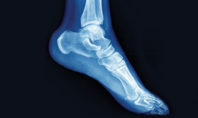Text Neck – Is You Cell Phone Ruining Your Posture?
Add “text neck” to the list of digital-age maladies, a condition caused by the unnatural position of the head as we look down repeatedly at cell phones, tablets and laptops.
In a chat, Harry Jenkins, outpatient orthopedic physical therapist at Lehigh Valley Health Network’s Cetronia Road clinic, discussed conditions caused by poor posture, their effect on overall health and mobility and what folks can do to maintain a healthy spine and avoid pain in a world where many can’t keep their eyes off digital devices.
Is text neck, a condition caused by staring at mobile devices, becoming common?
I cannot say that I’m seeing diagnoses from physicians formally declaring “text neck,” but neck issues related to poor prolonged postures are very common in our society. If not looking down for prolonged periods, patients may have poor ergonomics with regard to home or work computers. Many of us spend a great deal of time sitting with forward head slouched postures either stuck in traffic on Route 22 or watching television.
Is poor posture more prevalent in teens or older adults?
I haven’t seen this condition in teens referred for formal physical therapy yet, but I think it may become a problem in the future as these individuals age and the tissues in the neck, such as ligaments, discs and muscles, are put under prolonged stress out of their anatomically ideal position. Teens with poor posture spending prolonged periods in cervical flexion, with the head down looking at device, will be more likely to develop neck issues in the future.
Older adults develop neck issues as well, but these aren’t necessarily due to “text neck” but more likely due to the cumulative effects of years of poor posture in front of the computer, work station, television or doing other hobbies such as needlepoint or crocheting.
Can repeated use of a mobile device lead to an abnormal normal range of motion?
Yes. Prolonged positioning leads to what is known as “adaptive shortening” of tissues like muscles, tendons and ligaments. The “text neck” posture is with a forward head, looking down at the device. Try this experiment, as long as you don’t currently have neck or shoulder pain. First, crane your head forward as if looking down at your device. Next, slouch your shoulders forward. Now, try to turn your head to look over your shoulder. Chances are you can’t turn your head as far as normal, and it probably feels tight and uncomfortable. This is because the joints in the upper neck (cervical spine) are in more of a locked position. This forward head posture can lead to muscles tightening in the upper neck that attach to the base of the skull (occiput). This forward head posture can lead to headaches originating from the neck.
Now, with your shoulders slouched forward, try to raise your arms over your head. They probably don’t go as high as normal, and it’s probably a bit uncomfortable. In this posture, the shoulders have more limited motion and are prone to rotator cuff injuries due to the tendons not having enough space to function properly. A common diagnosis is “rotator cuff impingement.” Postural correction is vital in treating these conditions.
Can it affect student athletes’ ability to perform at their best in sporting activities?
Yes. Again, remember the forward shoulder, head forward posture. Imagine trying to throw a ball in that posture. If it was uncomfortable to just raise your arms overhead, imagine swimming 15 laps or throwing 60 pitches.
Safe tackling in football requires a strong neck, head held erect with a good cervical lordosis (curve in the neck). The most dangerous position for the neck in tackling is with the head down, the posture of “text neck.” The risk of fracture in the cervical spine is high in tackling with the head down. Proper posture and musculoskeletal balance are vital in reaching one’s athletic potential and decreasing the risk of injuries.
How does this poor posture lead to wear on the spine?
The “text neck” position reverses the normal load-bearing curve in the neck (lordosis). Reversing that arch in the neck puts more stress on structures such as the joints and cartilage discs between them, causing premature wear and not handling the load or weight of the head. Over time, the muscles in the neck adapt to that posture (adaptive shortening). Very tight or stretched muscles are not strong muscles, and the spine relies on strong muscles for stability and movement. If the spine is not stable and does not move properly, that will lead to premature wear.
Can poor posture lead to reduced lung capacity, heart disease or other conditions?
Let’s assume our slouched posture again. Now try taking a deep breath. Not very deep, was it? The diaphragm and rib cage function best in an erect posture, expanding and contracting to move air. Pulmonary function will be impaired by poor posture. This will have an impact on activities requiring endurance, whether athletics, climbing stairs or walking the dog.
If someone just can’t free themselves from their mobile device, what exercises or stretches can you recommend to maintain a healthy posture and minimize pain or discomfort?
Try holding your device closer to normal eye level versus looking down into your lap. Break up the prolonged postures. Change positions frequently but hold your head up. Periodically sit up straight and squeeze your shoulder blades together, stretching your chest muscles and firing your shoulder blade muscles. Squeeze the shoulder blades together and stretch your arms up over your head. Periodically look up to the ceiling, restoring the curve in your neck.
Sit up straight and gently tuck your chin inward toward your neck, working the deep muscles in front of your neck and stretching the upper muscles in the back of the neck near the base of the skull. Doing these exercises periodically to break up that prolonged “text neck” position and put your anatomy in its more ideal alignment.
Can you describe a recent case where a person came to the realization that their over-attention to their mobile device just wasn’t a healthy situation?
In treating spinal conditions, I want to know what body positions or activities make a patient’s pain better and what makes it worse.
I recently had a patient who regularly worked in the “text neck” position, head down looking at her device — in this case, her laptop. She also read in bed, lying flat on her back, and again with her head flexed forward, pillows behind her head.
When I asked her, the one position that aggravated her head was looking down. So in my evaluation, we checked her range of motion and pain with looking up (cervical extension).
Lo and behold, it made her pain better! Her homework was to look up to the ceiling 10 times per hour and to avoid the prolonged flexion (looking downward). She did this by modifying how she positioned her laptop, being placed more at eye level. Also, she sat up in bed, head erect, to read. She realized quickly the mechanical nature of her neck pain. Something made it better, something made it worse, and she was in control of it. With a few simple exercises and modifications, she was able to manage it.
What’s your best advice to someone who can’t live without their mobile device?
Avoid the prolonged “text neck” position by holding the device closer to eye level, neutral (normal) posture. Change positions frequently. Do the neutral posture exercises I mentioned above. Also, if you wear eyeglasses or contacts, make sure that your prescription is current! If you have to crane your head forward and squint at the screen, you’re putting more stress on your neck as well as your eyes.














